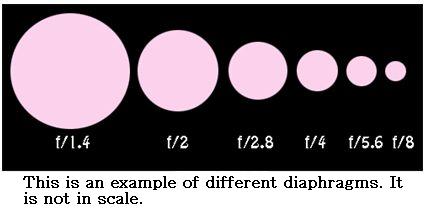The Diaphragm
The diaphragm controls the quantity of light which goes through the lens reaching the film or sensor. The diaphragm is located inside the lens and it is made from a ring of superimposed metal sheets. They open when we press the shutter button. How much it will open will depend on the f# (or diaphragm) we have established in the camera.
In older lenses found in manual SRL cameras and some lenses found in analogue SRL cameras, we have to select the diaphragm on the lens. In digital lenses and the majority of SRL camera lenses, you have to set the f# (sometimes called f stop) you want in the camera.

Depending on how open (wider) or closed (narrower) a diaphragm is, more or less light will get to the film or sensor.
The size of the opening of a lens is measured in f numbers: f#. The different diaphragms openings in lenses are:
1,4 2 2,8 4 5,6 8 11 16 22 32 45 64
An f/1,4 is the widest opening in diaphragms, and as a result, it allows more light to go through the lens. On the other hand, an f/64 is the narrowest opening found in diaphragms. It is the opening which allows the least amount of light to go through the lens.
Between one diaphragm and the next, there is 1 point in difference. What is this point equal to? It is twice as much or half as much.
An f# lets through twice as much light than the next f# or half the amount of light than the previous f# (1 point). For example, a diaphragm of f/8 allows 1 point less of light than a diaphragm of f/5.6. Thus, half the amount of light reaches the film or sensor. And vice versa: a diaphragm of f/5.6 allows 1 point more of light than a diaphragm of f/8, or twice as much.
There is no lens which has all diaphragm openings. For example, a 35mm lens can range from f/1,4 to f/22, and a large format camera can range from f/5,6 to f/64.
Newer lenses have mid-point diaphragms which can range from ½ of a point or 1/3 of a point.
EX: f/5.6 f/6.3 f/7.1 f/8 f/9 f/10 f/11. The f# in black represent whole numbers and those in red represent thirds of a point.
EX: f/5.6 f/6.7 f/8 f/9.5 f/11 The f# in black represent whole numbers and those in red represent half one point.
A lens with half points or thirds of a point will depend on the brand, model or the type of camera and lens you are using.
What you really need to know is which the whole numbers are to be able to take a picture properly. If you take pictures in an automatic manner, the camera will decide which diaphragm to use depending on the available light.
Lenses can be described as fast or quick (for example, open up to f/1,4) or slow (open up to f/4 or less). As we mentioned in previous lessons, a fast lens will allow us to take pictures in places with very little light without having to use a tripod. Fast lenses with open (wider) diaphragms lenses are always more expensive than closed (slow) diaphragms.
Why is a diaphragm or the opening in the lens important? As we mentioned before, the diaphragm controls the quantity of light that goes through the lens and reaches the film roll or sensor. The diaphragm is one of three variables (the other 2 are speed and sensitivity) that control a good photograph exposition. A correctly exposed picture received the correct (and necessary) amount of light; no more (the picture would be too bright), no less (the picture would be too dark).
However, the diaphragm controls more than that. Whenever we change the diaphragm, we also change the Depth of Field.

